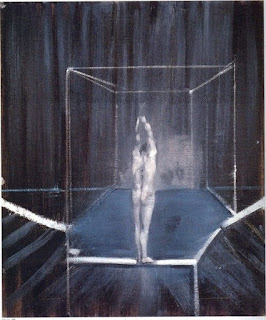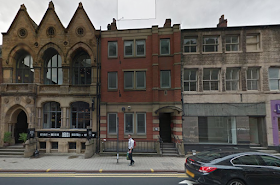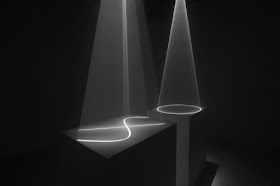The grid as a cage or trap is something that I have long been fascinated by. A cage or trap can easily be read as a 3D drawing and a 2D grid can just as easily be read as a cage or trap. Look at these images of cages and traps below, they are already iconic forms, you don't need to do anything with them, as they have such a powerful image presence. Because of this many artists have made use of the associations grids have with cages and traps.
Above 3D cages and traps, below 2D perspective grids, they have a very clear visual relationship.
An early example of the perspective grid being used to define a space for humans
Sir Edwin Henry Landseer, the Victorian painter, depicted animals and people behind the bars of a cage several times. The image below is though of special interest as it plays with the flatness of the painting. An image that was probably itself gridded to transfer it to canvas, is seen through a totally flat grid, (the bars of the cage) and the only intimation of space outside of the frame are the few objects placed on the shelf like space right at the bottom of the image. The objects are squeezed into the space behind the grid, the lion on the right hardly has space to exist, by giving the observer a few spatial clues such as atmospheric perspective and shadow play, Landseer tries to construct a believable space, but the flat grid works against this and we are somewhat disturbed by the 'dispute' between what is depicted and the underlying technicalities of how the space is made.
Mr. Van Amburgh, as He Appeared with His Animals: Sir Edwin Landseer 1847
Francis Bacon used the cage format to suggest that his figures were trapped or caged in some sort of existential dilemma. The recent exhibition at the Tate Liverpool was titled 'Invisible Rooms' which is another way to think about what the perspective frame represents.
Francis Bacon
He must have been aware of historical precedents such as the way Durer used perspective frames and the grid to measure his figures, however it is also likely that Bacon had looked at the example of Giacometti, who used the grid of measurement as a way to frame his images. He also of course looked at Eadweard Muybridge, who used grids in the backgrounds of his photographs in order to establish a frame of reference.
Giacometti
Eadweard Muybridge
Using a plumb line and horizontal straight in a how to draw manual
Bacon and Giacometti both used the idea of the frame to express something beyond the fact that it can be used to measure a spatial volume. The frame is as much a trap or a cage, and in occupying this dual position it is able to also express emotion and conceptual questioning.
A figure boxed in a how to draw book
Both Mona Hatoum and Louise Bourgeois have used the cage to express their feelings for the way that space or place can be both somewhere to live in and to be trapped by.
Louise Bourgeois
Mona Hatoum
The issues that underly the use of traps and nets were beautifully articulated in Alfred Gell's famous essay 'Vogel's Net: Traps as Artworks and Artworks as Traps' which I have dealt with in detail in an earlier post.
As the grid becomes a trap, it traps not only the animal inside it, but also the mind of the trapper.
The grid is a powerful image and it runs through many areas of art practice. I shall no doubt return again to the subject, but if you want to read through some older posts there are links to them below and all refer to grids and how they can be used within drawing.
The grid 1
The grid 2
The grid 3
The grid 4
Mona Hatoum











































